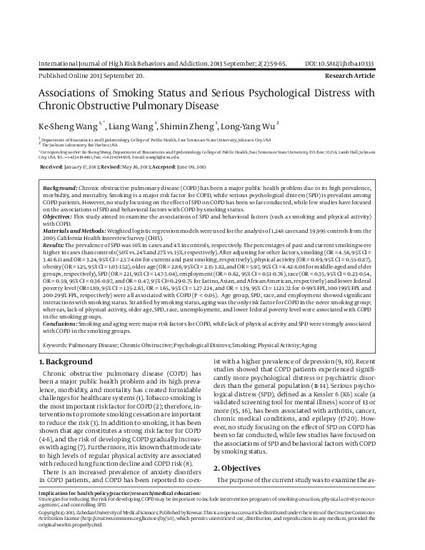
Background: Chronic obstructive pulmonary disease (COPD) has been a major public health problem due to its high prevalence, morbidity, and mortality. Smoking is a major risk factor for COPD, while serious psychological distress (SPD) is prevalent among COPD patients. However, no study focusing on the effect of SPD on COPD has been so far conducted, while few studies have focused on the associations of SPD and behavioral factors with COPD by smoking status.
Objectives: This study aimed to examine the associations of SPD and behavioral factors (such as smoking and physical activity) with COPD.
Materials and Methods: Weighted logistic regression models were used for the analysis of 1,248 cases and 39,995 controls from the 2005 California Health Interview Survey (CHIS).
Results: The prevalence of SPD was 10% in cases and 4% in controls, respectively. The percentages of past and current smoking were higher in cases than controls (50% vs. 24% and 27% vs. 15%, respectively). After adjusting for other factors, smoking (OR = 4.56, 95% CI = 3.41-6.11 and OR = 3.24, 95% CI = 2.57-4.08 for current and past smoking, respectively), physical activity (OR = 0.69, 95% CI = 0.55-0.87), obesity (OR = 1.25, 95% CI = 1.03-1.52), older age (OR = 2.86, 95% CI = 2.15-3.82, and OR = 5.97, 95% CI = 4.42-8.08 for middle-aged and elder groups, respectively), SPD (OR = 2.11, 95% CI = 1.47-3.04), employment (OR = 0.62, 95% CI = 0.51-0.76), race (OR = 0.35, 95% CI = 0.23-0.54, OR = 0.59, 95% CI = 0.36-0.97, and OR = 0.47, 95% CI=0.29-0.75 for Latino, Asian, and African American, respectively) and lower federal poverty level (OR=1.89, 95% CI = 1.35-2.63, OR = 1.65, 95% CI = 1.27-2.14, and OR = 1.39, 95% CI = 1.12-1.72 for 0-99% FPL, 100-199% FPL and 200-299% FPL, respectively) were all associated with COPD (P < 0.05). Age group, SPD, race, and employment showed significant interactions with smoking status. Stratified by smoking status, aging was the only risk factor for COPD in the never smoking group; whereas, lack of physical activity, older age, SPD, race, unemployment, and lower federal poverty level were associated with COPD in the smoking groups.
Conclusions: Smoking and aging were major risk factors for COPD, while lack of physical activity and SPD were strongly associated with COPD in the smoking groups.
Available at: http://works.bepress.com/shimin-zheng/21/

Copyright © 2013, Zahedan University of Medical Sciences; Published by Kowsar. This document was originally published in International Journal of High Risk Behaviors and Addiction.